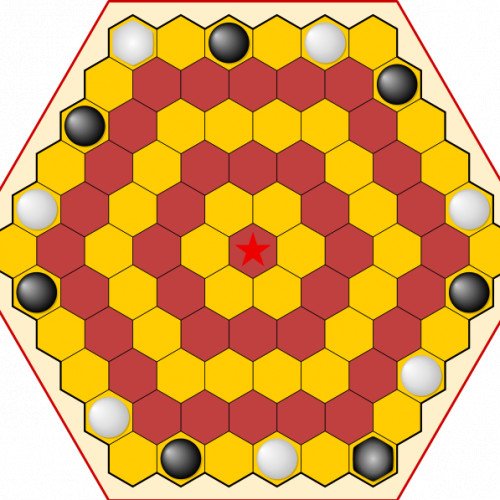AGON VS SHATAR

AGON
Agon (or Queen's Guards or Royal Guards) is an strategy game invented by Anthony Peacock of London, and first published in 1842. It is a two player game played on a 6×6×6 hexagonal gameboard, and is notable for being the oldest known board game played on a board of hexagonal cells. Each player has one queen and six guards. Players determine who moves first, then turns alternate. On each turn, a player moves one of his pieces. The object of the game is to be first to maneuver one's queen to the central hex (the throne) at the center of the board, and surround her with all six of her guards. The gameboard may be thought of as a series of concentric rings of hex cells (highlighted by rings of alternating colors). Pieces move one step at a time to an adjacent cell, either sideways in the same ring, or towards the throne to the next ring. The cell moved to must be vacant. Only the queen may move to the throne.
Statistics for this Xoptio

SHATAR
Shatar (Mongolian: ᠮᠣᠩᠭᠣᠯ ᠰᠢᠲᠠᠷᠠ Monggol sitar-a, "Mongolian shatranj"; a.k.a. shatar) and hiashatar are two chess variants played in Mongolia. The rules are similar to standard chess; the differences being that: The noyan (ᠨᠣᠶᠠᠨ, lord) does not castle. The küü (ᠬᠦᠦ, pawn) does not have an initial double-step move option, except for the queen pawn or king pawn. In old shatar rules, a pawn that reaches its eighth rank must promote to half-power tiger. But a pawn could step back to its sixth rank to promote to all-power tiger. It moves like a queen. The baras (ᠪᠠᠷᠰ or ᠪᠠᠷᠠᠰ, tiger; Persian: fers) moves like a promoted rook in shogi: like a chess rook or one square diagonally. It was called half-power tiger or half-power lion in old shatar rules. In modern shatar rules, a baras moves like a queen. The mori (knight; ᠮᠣᠷᠢ) cannot deliver mate. In modern shatar rules, the mori can give mate. The bishop (teme) and rook (terge) move as they do in standard chess. The game always starts by White playing 1.d4 and Black responding with 1...d5. This is the only time in the game a pawn may advance two squares; some sources claim this initial move can optionally be made with the e-pawn. In old shatar rules, Ujimqin player must make an initial double-step move with the queen pawn; in Chahar, the king pawn. In old shatar rules, baremate is draw. In old shatar rules, one special rule is called tuuxəi, like komi in Go. A player could leave the enemy with only two pieces remaining (noyan and another piece) at the end. Then he must start making checks using the terge or baras and make consecutive checks until checkmate. Before checkmate, number of consecutive checks is the number of tuuxəi. If a player wins by checkmate as in chess, he receives only one tuuxəi. A player usually leaves the enemy with one noyan and one küü to allow time to put his pieces into good positions for making consecutive checks.